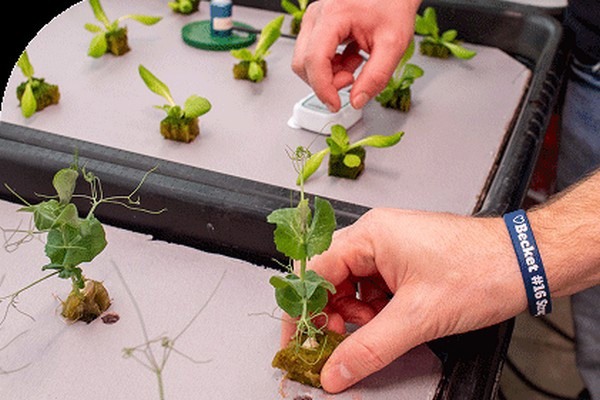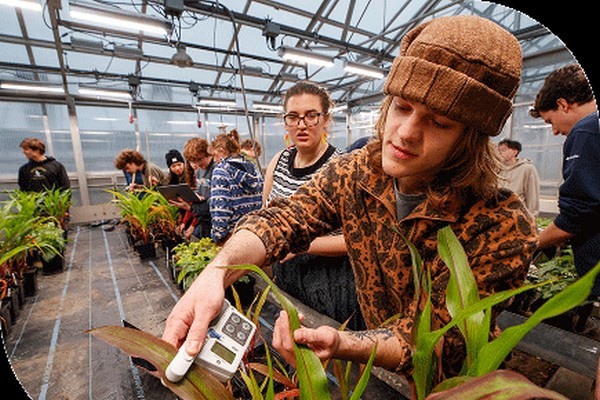One option that's become a focus of the University of Minnesota is controlled environment agriculture (CEA), which encompasses greenhouses (including deep winter greenhouses), hydroponics, and vertical farming. Compared to conventional agriculture, CEA incorporates slightly different inputs in varying degrees to optimize growth; namely, light, temperature, humidity, nutrients, and water.
At the University of Minnesota, CEA falls under the purview of Nate Eylands, assistant professor in horticultural science at the College of Food, Agricultural and Natural Resource Sciences.
Eylands is acutely aware of the need to protect the environment in our quest to produce more food. He majored in ecology as an undergraduate, and at one point wanted to study grizzly bears in Yellowstone National Park.
Since then he's been trying to find ways to balance natural lands and cultivated lands—which "don't play very well together a lot of the time," he says—in the best way possible, "and use controlled environments to grow more food per square meter and hopefully give some of that space back to biodiversity. The further I got into it, the more I fell in love with it, and plant science just became all-encompassing."
Controlled environment agriculture is one way to evolve our growing methods and help address the statistic that Eylands cites with a bit of awe. According to a report by the United Nations, by 2050 farmers will need to produce 70 percent more food than they did a decade ago to nourish a global population of nearly 10 billion.
"The number of (CEA growers) keeps increasing and increasing, and not only the number of entities but the square footage, as well. The more people that can do it, the better. I think it's a really great way to enter the agriculture space," said Nate.
Improving the cost-benefit ratio
Controlled environment agriculture has some striking advantages. It uses only about 10 percent of the water needed in conventional agriculture to grow the same amount of food. Credit that to hydroponics, where water recirculates through the system. Nutrients are also recycled, meaning that only about 10 percent of the fertilizer is used compared to traditional agriculture.
 © University of MinnesotaLettuce and snow pea seedlings growing in deep-water culture hydroponic systems
© University of MinnesotaLettuce and snow pea seedlings growing in deep-water culture hydroponic systems
The downside is that CEA is energy-intensive, both in terms of labor and also in light, heat, and other system needs.
"That is one issue that we definitely face right now in controlled environments is we ask for more money for that produce, because of the infrastructure, the energy, and the labor that it takes," Eylands says. "These are high-intensity crops."
On the return side, if energy costs (and consumer costs) can be lowered, CEA will go a long way toward feeding a growing demand for healthy foods by consumers in general and restaurateurs seeking farm/greenhouse-to-table produce.
"The growers and the purveyors doing this, they are trying their best to say, 'If you're going to pay that premium, we're going to give you a premium product," he says. "I think that's what controlled environments can bring is that quality—especially on that nutritive front," he adds. "[It's] being able to offer high-quality produce that tastes good, it looks good, it's full of vitamins and minerals, and it's not just crunchy water."
 © University of MinnesotaStudents measuring relative chlorophyll content in various plant leaves
© University of MinnesotaStudents measuring relative chlorophyll content in various plant leaves
Controlled environment agriculture can also be a wonderful fit for Minnesota farmers both old and new. Eylands points out that Minnesota is one of the leading agricultural states in the nation, "which is incredibly impressive for having such a short growing season. We have ag people who love to be in it and they're just looking for ways not to take the winter off."
"The number of (CEA growers) keeps increasing and increasing, and not only the number of entities but the square footage, as well," he adds. "The more people that can do it, the better. I think it's a really great way to enter the agriculture space."
Source: The University of Minnesota
